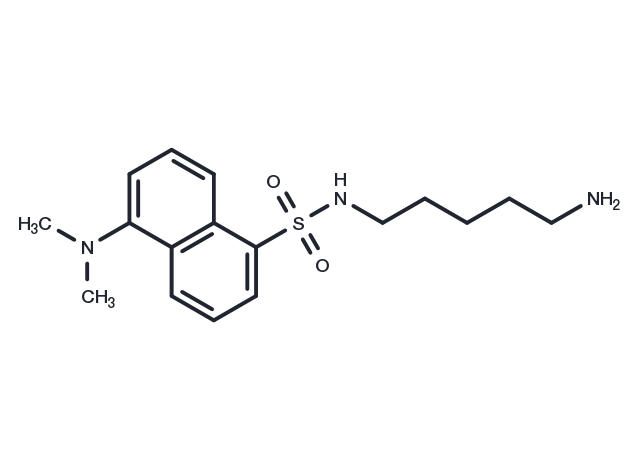keep away from direct sunlight
Powder: -20°C for 3 years | In solvent: -80°C for 1 year

Dansylcadaverine (Monodansyl cadaverine) is a fluorescent probe.

| Pack Size | Availability | Price/USD | Quantity |
|---|---|---|---|
| 10 mg | In stock | $ 29.00 | |
| 50 mg | In stock | $ 29.00 | |
| 1 mL * 10 mM (in DMSO) | In stock | $ 30.00 |



| Description | Dansylcadaverine (Monodansyl cadaverine) is a fluorescent probe. |
| In vitro | The amount of actin-thymosin β4 crosslink is very low in the presence of Dansylcadaverine and transglutaminase, while there are large amounts of Dansylcadaverine-labeled thymosin β4 and actin. The amount of cross-link further decreases in the presence of Dansylcadaverine competing for Lys residues of either G-actin or thymosin β4 (100 μM). In the absence of thymosin β4, Dansylcadaverine-labeled actin polymerized to F-actin. |
| Synonyms | Monodansyl cadaverine |
| Molecular Weight | 335.46 |
| Formula | C17H25N3O2S |
| CAS No. | 10121-91-2 |
keep away from direct sunlight
Powder: -20°C for 3 years | In solvent: -80°C for 1 year
DMSO: 60 mg/mL (171.7 mM), Sonication is recommended.
You can also refer to dose conversion for different animals. More
bottom
Please see Inhibitor Handling Instructions for more frequently ask questions. Topics include: how to prepare stock solutions, how to store products, and cautions on cell-based assays & animal experiments, etc.
Dansylcadaverine 10121-91-2 Autophagy Others vacuoles Inhibitor probe autophagic autofluorescent substrate inhibit Monodansyl cadaverine inhibitor
